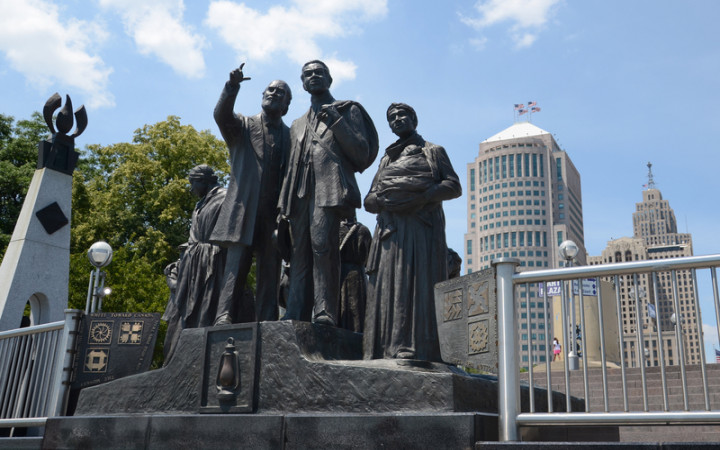Today’s Wonder of the Day was inspired by Wonder Team. Wonder Team Wonders, “What are spirituals?” Thanks for WONDERing with us, Wonder Team!
What is your favorite song? Why do you like it? Maybe you like dancing to a funky beat. Maybe you like the lyrics that remind you of a special person. Chances are, you like the way it sounds and the idea behind it. Music can be silly and fun, and it can also be full of meaning. Today’s Wonder is about music packed with extra meaning—spirituals.
Are you WONDERing what spirituals are? Spirituals are a kind of song. They are often called Black spirituals, because they were first sung by enslaved people in the United States. “Spiritual” can mean “religious,” and that gives us a clue as to what kind of songs these are. Spirituals are religious songs. They are also called religious folk songs. Folk music is traditional music that may be passed down through generations.
Black spirituals come from both African music traditions and European hymns. (Hymns are another kind of religious song.) When enslaved people were taken from Africa, they were forcibly separated from their homes and culture. Music was central to daily life in many West African cultures. Enslavers did not want enslaved Africans to sing or dance in their traditional ways, so they had to do so in secret. Singing and dancing were ways for Africans to hold on to their culture.
Enslavers introduced African slaves to Christianity. At first, most enslaved people wanted to keep their own beliefs. Over time, though, many enslaved people began to see their own lives in the stories of the Bible. The story of Moses freeing the slaves in Egypt is one example. Slaves in the U.S. began composing and singing spirituals in the 1700s. They mixed parts of their traditional music with some European Christian parts. The result is one of the first American art forms—the spiritual.
Spirituals have a special form. Many of them use call-and-response. This means that one singer starts (“call”) and others follow (“response”). This is a traditional African form of music that enslaved persons adapted to their new music. You might know call-and-response from children’s songs like “Boom Chicka Boom” or “Princess Pat.” They also used clapping, chanting, and dancing. One kind of song, called a “ring shout,” included clapping and dancing in a circle. Composers mixed these African elements with Christian lyrics to create spirituals.
Some Black spirituals are also known as “sorrow songs.” You may recognize ones like “Swing Low, Sweet Chariot” or “Nobody Knows the Trouble I’ve Seen.” They sound slow and sad. In these songs, enslaved people describe their sadness and struggle. Others are upbeat, as singers imagine better times and freedom. Enslaved people might have sung these in church meetings. These were often called “bush meetings” or “camp meetings” since they usually took place outside.
Many spirituals have coded meanings. We know that Harriet Tubman used the song “Go Down, Moses.” She helped many enslaved people escape on the Underground Railroad. Their enslaved composers use Christian symbols to say what they could not say openly. For example, “Moses” could mean someone who will save them from being enslaved. The River Jordan often represents the Ohio River, which divided slave states and free states. Enslavers might be called “Pharaoh” and slave owning states, “Egypt.” Canaan is a stand-in for free states. Using these symbols helped enslaved people stay safe while also letting them communicate with each other.
In the 1800s, a few people began writing and collecting spiritual music. These songs became very popular with white Americans. Some even claimed that because enslaved people sang spirituals, it meant that they were happy. Former enslaved people like Frederick Douglass explained how wrong that was.
After the Civil War, groups of Black singers began to sing spirituals for audiences. One of the most famous groups was the Jubilee Singers. These singers were formerly enslaved and attended Fisk University in Tennessee. They became very well known, and toured the United States and Europe.
Spirituals are not sung very often now, but they influenced many other kinds of music. Black musicians in the South built on spirituals to create blues and jazz music. In turn, other musicians borrowed from them to create what we now know as rock ‘n’ roll. Even modern hip-hop can trace its origins back to Black spirituals. Listen to some spirituals and see what you think—one might even be your new favorite song!
Standards: CCRA.R.1, CCRA.R.2, CCRA.R.10, CCRA.L.3, CCRA.L.4, CCRA.L.5, CCRA.L.6, CCRA.W.4, CCRA.SL.2, CCRA.SL.4, C3.D2.His.1, C3.D2.His.2, C3.D2.His.3, C3.D2.His.4, C3.D2.His.5, NCAS.CR.1, NCAS.CR.2, NCAS.CR.3, NCAS.RE.7, NCAS.RE.8




